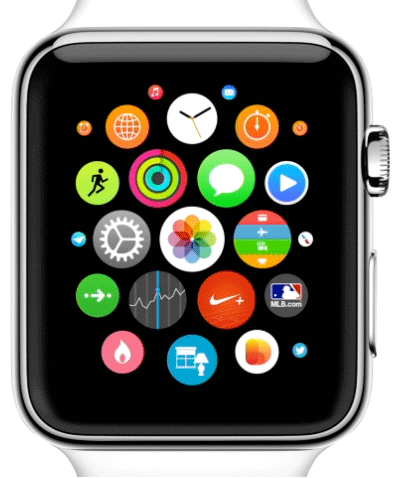Why Publishers Need to Pay Attention to Smartwatches
Smartwatches are the new generation of mobile – and like smartphones, much of their value will come from the apps that bring utility, information and entertainment to the consumer. In just a few years, half of app interactions will come from wearables, predicts Gartner – publishers should make sure that they get their piece of this pie!
The announcement of the Apple Watch has focused attention on the wearable category of smartwatches. The smartwatch promises to be a more personal device than the smartphone, offering a one-to-one connection with the consumer. Companies such as Pebble, Sony and Samsung have already been offering these devices and others have also announced products but so far, their efforts have not grabbed the attention of the mainstream. Clumsy user interfaces and lack of useful apps have limited their appeal. With the arrival of Apple and Google powered smartwatches towards the end of this year and early 2015, combined with increasing consumer awareness, these devices may finally make their way into the mainstream over the next few years.
Consumer Adoption
Consumer attitudes towards wearable devices are shifting and projections show significant adoption in the coming years. Jay Dettling, President of Acquity Group (now part of Accenture Interactive), said, "These digital devices present major opportunities for improving a brand's customer experience for a range of consumers. Our data reveals that it's not only tech enthusiasts who are interested in these kinds of products, but late adopters who also express interest in buying them." Acquity Group’s Internet of Things survey polled 2,000 U.S. consumers on their attitudes towards owning wearable devices (keep in mind this was before the introduction of the Apple Watch):
- 22% already own or plan to buy a wearable device by 2015 and 43% planned to buy within the next 5 years.
- 24% of self-described late adopters planned to buy in next 2 years and 62% planned to buy in next 5 years.
Smartwatches will likely end up being a large percentage of the wearable devices people buy. Business Insider projects that smart wrist devices will comprise 70% of wearable device shipments throughout the next 5 years.
Apps will drive adoption
Third party apps will be a critical driver of smartwatch adoption. Up to now, there have been too many different wearable device platforms and a relatively small consumer base to develop for, resulting in a relatively small number of apps. Pebble has been the most successful at getting developers to create apps for its smartwatch with over 1,000 in its app store. With the entry of tech giants Apple and Google, they will likely overtake Pebble since both already have a critical mass of developers creating apps for iOS and Android. These developers will be looking to move existing apps and create new ones for the smartwatch platform using Apple’s WatchKit and Google’s Android Wear APIs. Gartner predicts that by 2017, wearables will account for half of total app interactions.
Impact on Media
Media consumption will change as people turn to the small but always present and easily accessible device for information and utility on the go. Publishers will have the opportunity to reach the user with the right message at the right time if they consider the smartwatch form factor and the ways people will use it. This will change how content is produced and consumed. How is unclear at this point but there are many hypotheses. So what should publishers do? Here are some thoughts:
- Experiment with smartwatch apps. How can you engage new and current readers on these platforms? Which of your content is relevant and appropriate for the smartwatch?
- Given the form factor and likely usage of the smartwatch, content has to be snack sized. It has to make sense to consume on a wrist, ideally hands free.
- There is no way a single company can think of all the possibilities. Publishers will have their own ideas about apps. But they should also leverage the experience and expertise of the large developer community by offering open APIs. Open APIs enable developers to use content in ways that haven’t even been imagined yet. And hackathons are great platforms to tap into developer communities.
- Data will be critical to experimentation and efforts. Understand how consumers are engaging with and sharing your content so you can smartly iterate and inform your next efforts to be more effective.
Some media companies have already been active on wearables. Here are a couple of notable efforts:
- FT launched their fastFT app on Samsung Gear S in August 2014. FT partnered with text streaming provide Sprtiz to develop it.
- ESPN offers SportsCenter app for Pebble that provides live scores and brief updates about a user’s favorite teams or leagues. The app also notifies the user of score changes by buzzing the Pebble device.
Other companies are also bringing wearable devices into their strategies. Salesforce.com launched their Wear Platform this summer, which already supports a wide range of devices including Pebble, Android, Google Glass and Oculus. Daniel Debow, SVP of Emerging Technologies at Salesforce.com, said, “Wearables are the next phase of the mobile revolution. With Salesforce Wear, companies can now capture the massive opportunity these devices offer to connect with customers in new ways.” Something publishers should be thinking about as well.
The Digital Innovators’ Summit 2015 will cover wearables with a focus on smartwatches. Attendees will be able to try out a variety of wearable devices. And we are planning to have a wearable expert who shares insights into how publishers should be approaching wearable devices. Come join us from 23-24 March 2015 in Berlin to find out more!





